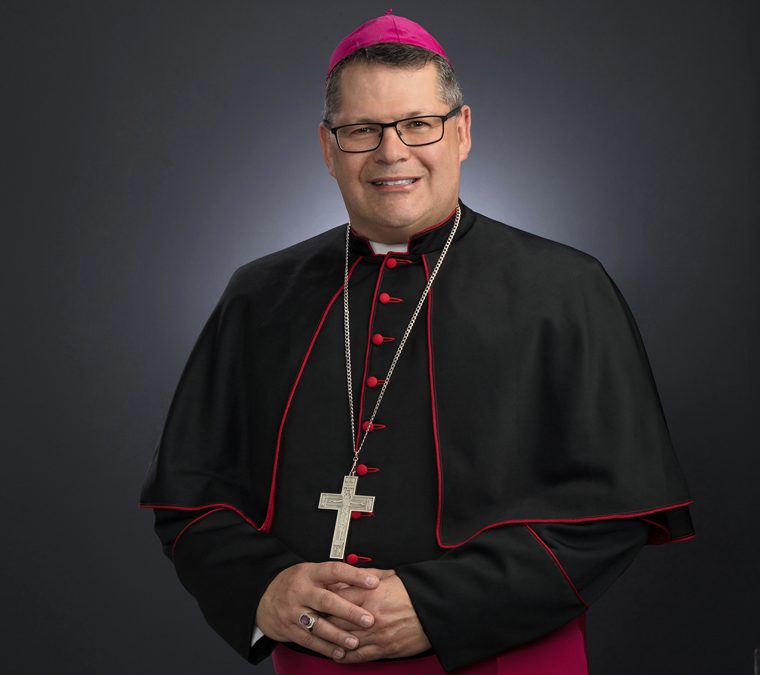It has only been two months since I was in the Eternal City, but I find myself here again this week, taking in the sights of Rome. Since I am staying at the Pontifical North American College on the Janiculum Hill for this trip, I have a fantastic view of St. Peter’s dome [see photo below]as a backdrop. The bishops of New York State are in the midst of a special pilgrimage to the tombs of the Apostles Peter and Paul, known as the “ad limina apostolorum,” meaning “to the threshold of the apostles.” As I wrote in last week’s column, this is a week for prayer, meetings, and dialogue with Pope Francis and the Curia (the Offices) of the Holy See. Its basis is found in a report submitted by Bishop Cunningham and our diocesan staff, which I have read in preparation for these meetings — but I have also taken Bishop Cunningham with me as backup!
The substance of my visit with Pope Francis and the meetings with the various offices (dicasteries) I will report on at a later date, after having time to digest and synthesize. However, I thought you might be interested in some of the places associated with the pilgrimage. Of course, two of the main sites of the pilgrimage are the tombs of Saints Peter and Paul, but during the week the bishops will celebrate Mass in the four major basilicas of Rome.
On Monday, the site of our Mass was the Basilica of St. Mary Major. [See the story and photos beginning on the cover of this issue.] A basilica is not a cathedral, which is the principal church of a diocese. Rather, it is a title of honor given to church buildings that are distinguished either by their antiquity or their role in a community because of their association with a major saint or an important historical event. In the Diocese of Syracuse, Sacred Heart Church on Park Avenue is designated with the honorary title of “Minor Basilica” because of its historical and international significance to this local Church.
The Basilica of St. Mary Major is one of the oldest and most important shrines in the world dedicated to the Blessed Virgin Mary. According to tradition, the Virgin Mary appeared to a childless couple as well as Pope Liberius. In both instances, she said a miraculous snowfall would occur that would outline where the church was to be built in her honor. On August 5, 352, snow did fall on the Esquiline Hill in Rome in the middle of a heat wave. The people staked off the outline of the future basilica before the snow could melt. Pope Liberius immediately ordered the basilica to be built. Two noteworthy treasures in the basilica are a relic of the manger from Bethlehem and a painting of the Blessed Mother known as “Salus Populi Romani” (Salvation of the Roman People). Pope Francis comes to pray before this image of Our Lady before and after each international trip he makes.
On Tuesday evening at 6 p.m., the New York bishops gathered at the Basilica of St. Paul Outside the Walls for Mass and prayer at the tomb of St. Paul. Erected during the 4th century AD, it is the second-largest of the four major basilicas, after St. Peter’s Basilica. It was founded on the burial ground of St. Paul. It is known for its striking cloister area and for the medallions of all the popes that ring the nave.
On Thursday morning, the bishops of New York will gather for Mass at the Tomb of St. Peter. While it is neither the mother church of the Catholic Church nor the cathedral of the Diocese of Rome, St. Peter’s is regarded as one of the holiest Catholic shrines. Catholic tradition holds that the basilica is the burial site of Saint Peter, chief among Jesus’ apostles and also the first Bishop of Rome (Pope). Saint Peter’s tomb is directly below the high altar of the basilica. For this reason, many popes have been interred at St. Peter’s since the Early Christian period, and there has been a church on this site since the time of the Roman emperor Constantine the Great. Construction of the present basilica, which would replace Old St. Peter’s Basilica from the 4th century AD, began on April 18, 1506, and was completed on November 18, 1626. This edifice could be described as the pope’s church because of its connection to the Vatican City State. Consequently, many papal liturgies are conducted in this church.
Our last public Mass in Rome will be at St. John Lateran, the pope’s cathedral, considered to be the “mother” of all churches throughout the world. Founded in the 4th century, it is named both for St. John the Baptist and St. John the Evangelist. “Lateran” refers to the palace that was handed over to the Church by Emperor Constantine in the 4th century. Its famous baptistery was actually the only baptistery in Rome for many years. It is said that the central bronze doors of St. John Lateran actually come from the old Roman Senate building.
Of course, during the week, I hope to visit other favorite Roman churches for moments of prayer, as well. There are many but some of my favorites are the Gesu, Santa Maria in Sopra Minerva, St. Ignatius, and St. Anne’s Church in the Vatican. Again, know that you are with me in prayer, but I am looking forward to being back among you as we get ready for Thanksgiving Day, and quickly following, the holy season of Advent.
God’s blessings on your week!







